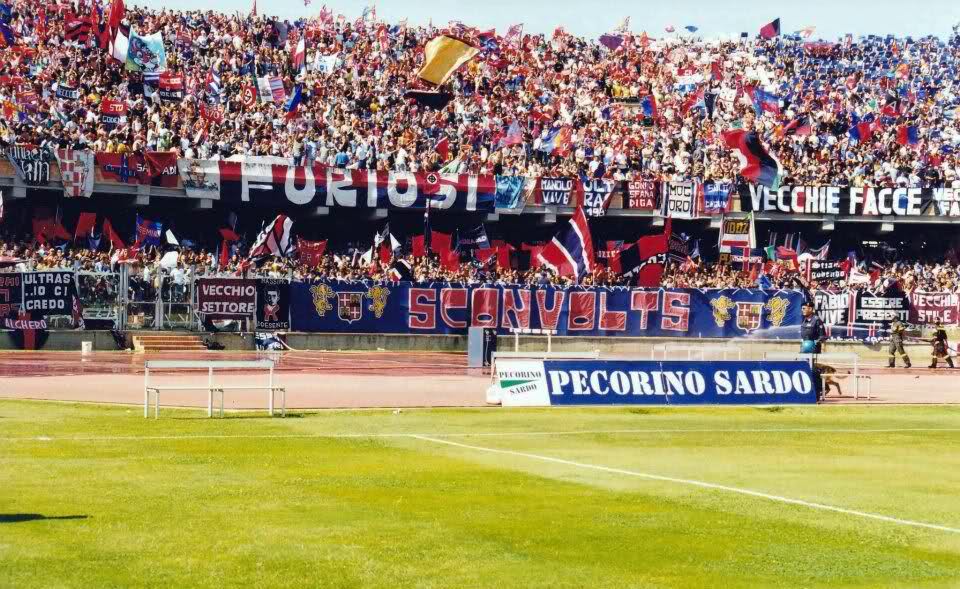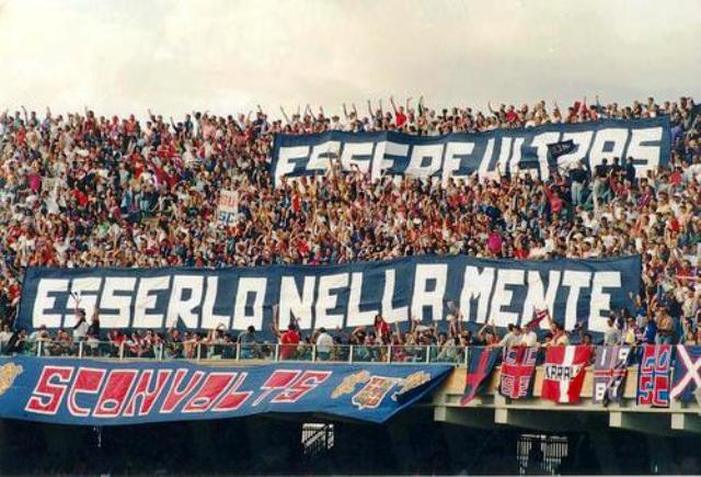Stadium: Stadio Sant’Elia, capacity 23,486
The Stadio Sant’Elia lies in the beautiful setting of Sardinia and must be one of the most picturesque venues in Italy. The stadium was built in 1970 following Cagliari’s first and last Scudetto triumph and has been recorded to have held 70,000. The ground went through major refurbishing for Italia 90, when the capacity was reduced to 39,905. English fans might recognise this stadium, as Bobby Robson’s team played their World Cup group games in the ground.In the last 20 years the club has bounced between Italy’s top two divisions and the attendances have dropped. A controversial move was made to erect two new stands over the running track in the north and south ends of the stadium so the fans had a better view. This decreased the capacity to 23,486 and effectively created a stadium within a stadium, which certainly gives it a strange appearance.
The atmosphere in the Stadio Sant’Elia can be quite laid back for the Italian game, although the Cagliari Ultras – especially the Sconvolts 87 – can produce some excellent choreographed displays when rival clubs visit. The form of the team has a profound effect on the feeling in the stadium, although as an island people the volume can be cranked up when necessary.
The stadium was closed in 2012 due to safety concerns, which took Cagliari to the equally unsafe Stadio Is Arenas and eventually led to the farcical games in Trieste last season. Renovations are now taking place that will make the Stadio Sant’Elia Cagliari’s home once more.
They are playing at the Stadio Sant’Elia at present but attendances are low, often around 9,000. The debate about the ground still rolls on, with appeals and court cases about how it should be developed. All Sardinians are hoping this will be resolved soon and they can watch their football in a beautiful environment again.
The Ultras
In John Foot’s book, Calcio: a history of Italian football, there is a striking vignette of a funeral procession being led by Cagliari fans following their Serie A triumph in 1970.The Cagliaritani are carrying little coffins through their narrow cobbled streets mourning La Vecchia Signora (The Old Lady). After beating them to the title the fans have decided to bury Juventus. It is a typical example of how Italians often mix Calcio with religious sentiments and it also demonstrates the Cagliaritani‘s sardonicism, a word entirely appropriate due to its definition and etymology; the Greeks believed eating a plant from Sardinia caused facial convulsions resembling those of sardonic laughter.Cagliari is the biggest club on the island of Sardinia. Their ground Lo Stadio Comunale Sant’Elia has only recently started to host games again due to its decrepit state, however, in the late 1980s its Curva Nord was renowned for being one of the most colourful and vibrant in Italy, producing spectacular choreographies with witty and innovative banners.
This was partly inspired by the birth of Cagliari’s most famous Ultra groups, theSconvolts in 1987 and I Furiosi in 1989. The Sconvolts, whose name comes from the word sconvolto, which means shocked or deranged, were formed as a subgroup of both the Cagliari Ultras Curva Nord and Eagles 1985. I Furiosi on the other hand was formed by ex-members of the Sconvolts and a number of other small groups.
The Ultras of Cagliari are an unorthodox bunch and they differentiate themselves as “duro e puro” (“tough and pure”). It is an aphorism which suits them. Unlike many Italian Ultras they were renowned not for their violent nature, but for their dedication and passion, especially during la trasferta (the away day). This was largely down to geography. For many the ferry was the only viable option and we are not talking about Dover to Calais. Cagliari to Rome takes 13 hours and that doesn’t include travel on the mainland. Despite the long and gruelling journeys, the Ultras relished la trasferta and their stalwart support for I Rossoblu has earned them respect all over Italy.
Yet, in what is becoming a recurring theme, deep underlying divisions existed between their principal groups. This was born from a difference in mentality and ideology. While the Sconvolts remained apolitical, I Furiosi held right-wing sympathies and this meant they had their own twinnings and rivalries. Until 2012, the Sconvolts only recognised true ties with Foggia, whereas I Furiosi had friendships with the Veronese, Interisti and Wild Kaos Atalanta.
I Furiosi also developed a famous rivalry with the Milanisti after they managed to steal a striscione (banner) at one of Cagliari’s home games. Losing a striscione to a rival is shameful; it is the modern day equivalent of losing the king’s colours in battle. This shame was compounded when the Milan Ultras proceeded to reveal this banner at the next game between the two sides. One account even reports a grown man crying with despair at the sight of it.
The incurable differences between the Cagliaritani meant they occupied different positions on the Curva Nord and in 2003 this conflict reached its peak. The Sconvolts travelled to their game against Verona with the sole aim of revenge. It was meticulously planned. They travelled in small groups so not to attract attention from the police. Arriving in the city they gathered behind the Curva Sud of the Stadio Bentegodi (the realm of the Verona Ultras) and they waited with iron bars, sticks and smoke grenades.
All hell broke loose, a bar was wrecked, fights raged with the Veronese, two police were hospitalised and 33 Sconvolts were arrested. In the aftermath of the fight, the Veronese posted the following on a fan forum “It was a fair fight, without the use of knifes… Honour and respect to the Sconvolts.”
The tranquil reputation that followed the Cagliaritani had vanished. But here comes the truly shocking part. This vendetta was a consequence of events that had occurred in Cagliari five months earlier. At the corresponding home fixture, members of I Furiosi had teamed up with Verona Ultras and attacked theSconvolts. It was the gravest of insults and one the Sconvolts could not ignore. TheFuriosi disbanded later that year and while the exact reasons are hard to ascertain, it was certainly connected to this incident.
Today the Sconvolts remain famous across Italy. Although their numbers have dwindled due to a large proportion of their recent home games being played in Trieste (666 miles away), their old adage of “pochi ma buoni” (“few but good”) is truer now than ever.
They remain passionate and loyal and their slogan “Essere ultras esserlo nella mente” )Being Ultras is a state of mind”) is famous nationwide. This is encapsulated in a quote by a member of the Sconvolts: “Nobody in their right mind would leave their family on a Saturday to travel to Trieste to watch the last game of the season with nothing riding on it. It’s the purest of passion with no logic”
Classic player: Enzo Francescoli
When Ariel Ortega had his testimonial for River Plate in 2012, he invited many of the legends that had worn the famous white and red shirt. Ortega’s show was stolen by 50-year-old Enzo Francescoli, who scored four goals – including a spectacular bicycle kick.
The Uruguayan, who is of Italian descent, was one of the most talented players to emerge from South America in the 1980s. Nicknamed “Ill Principe“, his official position was attacking midfield, but like so many of the great players, it was sometimes impossible to pin down where he actually played.
His fluidity and superb movement made him idolised by many. One aspiring player who watched him avidly during the 1989-90 season in Marseille was Zinadine Zidane. The Uruguayan had so much influence on the French World Cup winner that he not only waxed lyrical about his hero in later years but he also named his son Enzo.
Francescoli arrived in Sardinia in 1990 after signing for Cagliari after Italia 90.Serie A was the world’s best league by some distance and the creative South American only added to its riches. In three seasons with Cagliari, Francescoli played 98 times and scored 17 goals. Francescoli and fellow Uruguayans Marcelo Tejera and José Herrera helped Cagliari finish sixth in the 1992-93 season and qualify for the Uefa Cup.
He led by example during this period and flourished in the division, showcasing some mesmerising ability. His skill level was second to none and his quick burst of speed matched with his incredible calmness saw him glide past defenders with considerable ease.
His finishing was immaculate and although his first thought was always to set up a team-mate his ability to strike from distance or one-on-one with the keeper was exemplary. He had a knack of hitting the ball early when approaching an oncoming keeper that would catch him at his weakest point and ultimately result in a goal. His set pieces also seemed to have tranquillity about them. He seemed to have the ability to stroke the ball into the net as though he was putting a brush to canvas, even from 35 yards out.
Seeing Francescoli at this time was quite simply a pleasure and although he moved to Torino for a season in 1993, he really made his mark in Sardinia. Serie A had some of the best defenders ever seen in world football at this time and too many of them had sleepless nights thanks to Ill Principe. When Calcio ruled the world, Zidane was watching Francescoli in awe.


